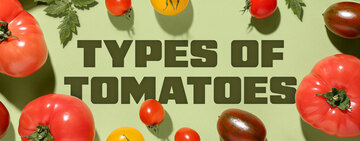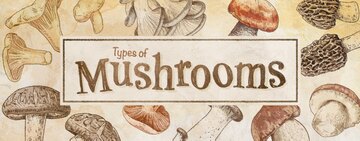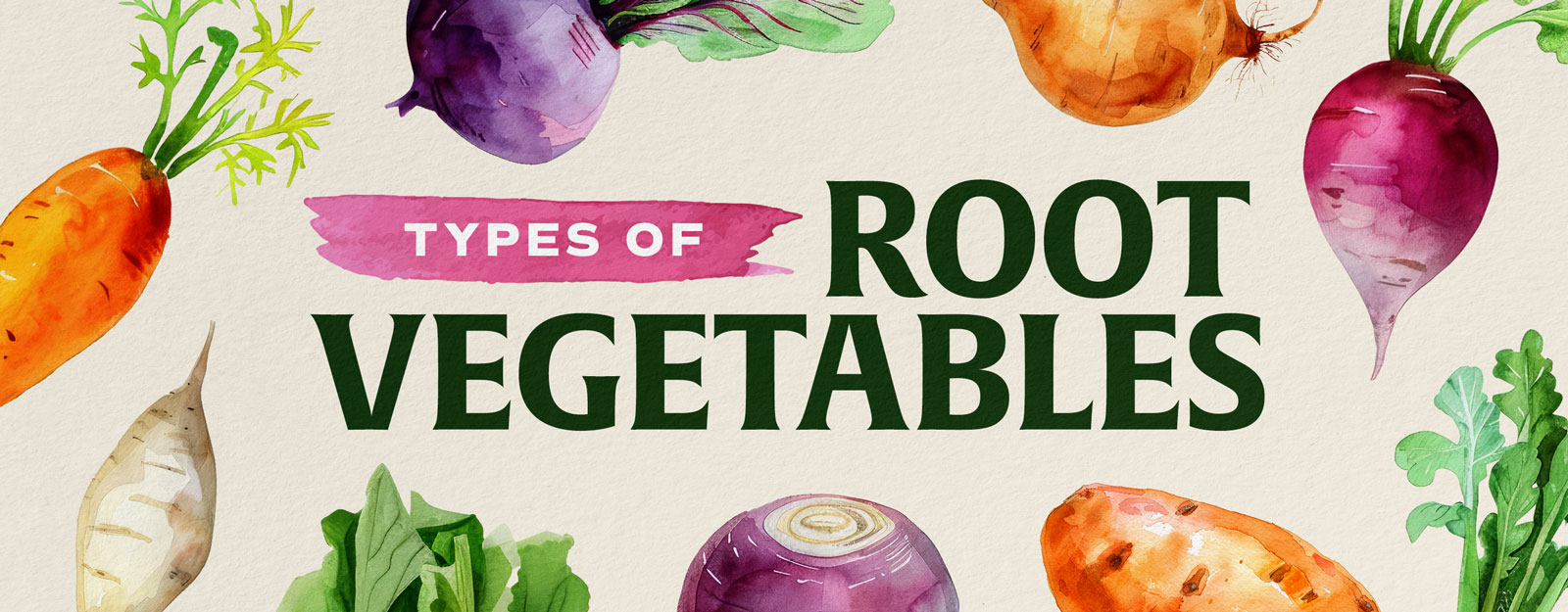
Root vegetables are essential ingredients for many recipes, valued for their versatility, flavor, and nutritional benefits. From hearty staples like potatoes and carrots to unique options like parsnips and rutabagas, these underground gems bring a range of textures and tastes to dishes in any season. Understanding the categorizations, appearance, flavor profiles, preparation, and how to peel and wash different root vegetables is critical to maximizing their potential in any professional kitchen setting.
Types of Root Vegetables
Root vegetables fall into two main classifications: true roots and non-roots. Each type brings unique textures and flavors to the kitchen, offering various culinary possibilities.
True Roots
True roots are distinguished as tuberous roots or taproots. Tuberous roots, such as sweet potatoes, are enlarged, fleshy roots that store nutrients and provide a starchy, hearty texture. Taproots, like carrots and radishes, are long, central roots that grow vertically and offer a more fibrous and crunchy bite.
Non-Roots
Non-roots are plants that grow underground, but unlike true roots, they derive from other plant parts such as stems or bulbs. These are divided into several subcategories:
- Bulbs, like onions and garlic, are made up of layered leaves and offer strong, pungent flavors.
- Corms, such as taro, are short, thickened underground stems with a starchy and nutty taste.
- Rhizomes, including ginger and turmeric, grow horizontally underground and deliver bold, aromatic flavors.
- Stem tubers, like cassava, develop from thickened underground stems and are prized for their soft, starchy flesh when cooked.
1. Onions
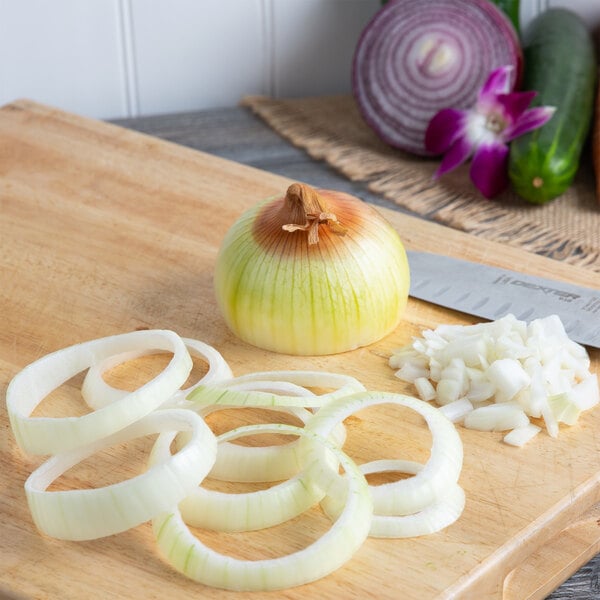
Onions are one of the most commonly used root vegetables in kitchens worldwide, prized for their flavor-enhancing qualities and versatility. With a sharp, pungent bite that mellows into sweetness when cooked, onions add depth to a wide variety of dishes. They come in many different varieties with distinct characteristics, making them essential for raw and cooked preparations.
- Class: Bulb
- What do onions look like? Round with papery skin ranging from white and yellow to red and containing layered fruit beneath it.
- What do onions taste like? Pungent and sharp when raw, sweet and mild when cooked.
- How to clean onions: Rinse the onion under cold water and peel off the outer papery layer.
- How to use onions: Onions can be sliced, diced, caramelized, roasted, grilled, or pickled. Use them in soups, stews, salads, sauces, and garnishes.
- How to store onions: Keep them in a cool, dry, and well-ventilated area. Separate onions and potatoes, as they can cause each other to spoil faster.
Types of Onions
The following are the different types of onions chefs use to craft dishes.
- Yellow Onions: Mild and sweet when cooked, ideal for soups and sauces.
- Red Onions: Best used raw in salads and sandwiches, offering a sharp, peppery flavor.
- White Onions: Crisper and sharper flavor, commonly used in salsas and stir-fries.
- Sweet Onions: Less pungent and are ideal for roasting and caramelizing.
2. Potatoes
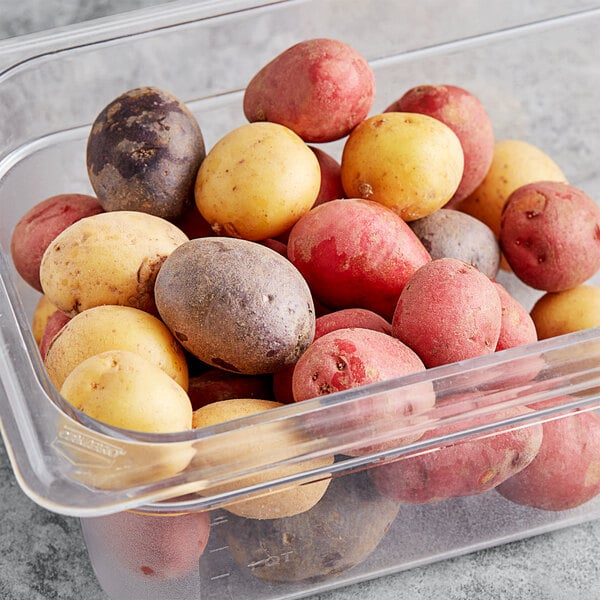
Potatoes are a staple in kitchens across cultures and service styles, known for their versatility and ability to complement nearly any dish. They have a mild, earthy flavor that becomes creamy and rich when cooked. Depending on the variety, potatoes can be used in most cooking methods, from boiling and baking to frying and mashing. These tuberous roots are packed with essential nutrients like potassium and vitamin C, making them valuable in professional kitchens.
- Class: Tuberous root
- What do potatoes look like? Round or oval in shape with skin that ranges from thin and smooth to thick and rough, in colors from brown to red or purple.
- What do potatoes taste like? Mild, earthy flavor that varies slightly by variety, with starchy or waxy textures.
- How to clean potatoes: Rinse potatoes under cold water to remove dirt. Scrub the skin using a vegetable brush, especially for unpeeled preparations.
- How to use potatoes: Potatoes can be boiled, mashed, baked, roasted, or fried. They are used in countless dishes, including mashed potatoes, french fries, roasted potatoes, soups, stews, and potato salads.
- How to store potatoes: Store in a cool, dark, and dry place. Avoid refrigeration, which causes potatoes to develop a sweeter taste and alter their texture.
Different Types of Potatoes
There are many different types of potatoes, each with unique flavors, textures, and nutrients.
- Russet Potatoes: High-starch that becomes fluffy when cooked, ideal for baking and frying.
- Yukon Gold Potatoes: Medium-starch, great for mashing, roasting, and boiling; creamy texture.
- Red Potatoes: Low-starch, excellent for boiling and roasting; firm and waxy texture.
- Fingerling Potatoes: Small, waxy, and buttery, perfect for roasting or pan-frying.
- Purple Potatoes: High in antioxidants, visually striking with an earthy flavor; good for roasting or making colorful mashed potatoes.
3. Garlic
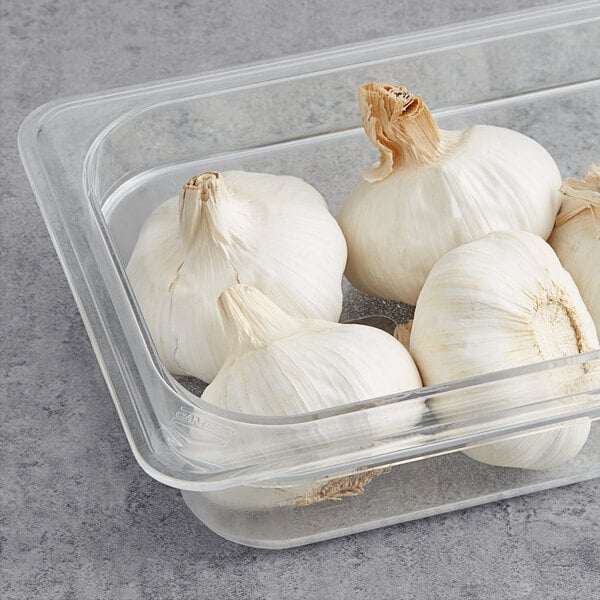
Garlic is a pungent, flavorful bulb that adds depth and intensity to countless dishes. It belongs to the allium family, which also includes onions and leeks, and is known for its distinct aroma and sharp taste that mellows when cooked. Garlic is commonly used as a seasoning or key ingredient in various cuisines, from Italian pasta sauces to Asian stir-fries. With numerous health benefits, including boosting immunity and reducing inflammation, garlic is a must-have ingredient in professional kitchens.
- Class: Bulb
- What does garlic look like? A papery white or purple bulb made up of smaller cloves, encased in a papery husk.
- What does garlic taste like? Sharp, spicy, and pungent when raw; becomes sweet and caramelized when roasted or sauteed.
- How to clean garlic: Peel away the papery outer skin of the bulb and separate the cloves. Trim the root end, then peel the individual cloves by crushing them lightly with a knife to remove the skin.
- How to use garlic: Garlic is minced, sliced, or crushed, then sauteed, roasted, or added raw to salads and dressings. It is essential in flavoring meats, vegetables, sauces, and soups.
- How to store garlic: Store garlic bulbs in a cool, dry place with plenty of air circulation. Avoid refrigeration to prevent sprouting. Once peeled or minced, store garlic in an airtight container in the fridge for up to a week.
Types of Garlic
The following types of garlic are staples in the kitchen.
- White Garlic: Most common type with a sharp flavor; typically softneck.
- Purple Stripe Garlic: Attractive purple-streaked bulbs; usually hardneck.
- Elephant Garlic: Larger, milder-flavored variety, technically a leek.
- Black Garlic: Fermented garlic with a sweet, molasses-like flavor.
Hardneck vs Softneck Garlic
The primary distinction between hardneck and softneck garlic is their growing conditions and flavor profiles. Hardneck garlic produces a flowering stalk, known as a scape, and is more tolerant of colder climates. It tends to have fewer but larger cloves with more intense flavor. Softneck garlic lacks a central stalk and has a longer shelf life, often used in warmer climates. Softneck varieties typically have smaller cloves and a milder taste, making them ideal for braiding and long storage.
4. Rutabaga

Rutabaga is a hearty root vegetable that combines the sweetness of a carrot with the earthy bitterness of a turnip. This vegetable is popular in European and American cuisines, often served roasted, mashed, or added to soups and stews. Its dense texture holds up well to various cooking methods, making it a versatile choice for many dishes. Rutabaga is a cool-weather crop that thrives in colder climates and is known for its long storage life.
- Class: Tuberous root
- What do rutabagas look like? Round, with thick, purple, and yellow skin. Its flesh is yellowish and firm.
- What do rutabagas taste like? Slightly sweet, earthy, and mildly bitter, with a flavor that deepens when cooked.
- How to clean rutabagas: Scrub under cold water to remove dirt. Trim off the top and bottom ends, then peel away the thick skin with a knife or vegetable peeler.
- How to use rutabagas: Rutabaga can be roasted, mashed, boiled, or added to stews. It’s often used as a substitute for potatoes in mashes and gratins or cubed for roasting with herbs and olive oil.
- How to store rutabagas: Store rutabaga in a cool, dark location, or refrigerate in a plastic bag for several weeks. They can last for months when stored properly.
Rutabaga vs Turnip
While rutabagas and turnips are part of the Brassica family, they have distinct differences in appearance and taste. Rutabagas are larger, have thicker skin, and sport yellowish flesh with a purple top. They also have a slightly sweeter and less peppery flavor than turnips. Turnips are typically smaller, have white flesh with purple-tinged tops, and offer a sharper, more peppery bite. Turnips are best suited for raw dishes like salads, while rutabagas shine in hearty cooked preparations.
5. Beets
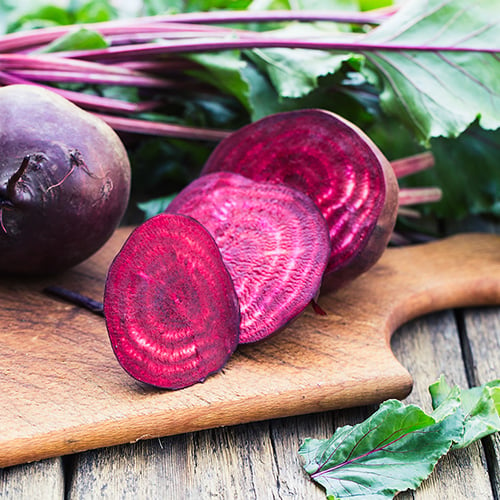
Beets are vibrant, nutrient-dense root vegetables with a sweet, earthy flavor. They are often roasted, boiled, or pickled and are rich in antioxidants, vitamins, and minerals. Their naturally deep color makes them popular in juices, salads, and desserts. Beets come in various colors, adding flavor and visual appeal to dishes.
- Class: Tuberous root
- What do beets look like? Round or slightly elongated with thick, edible skins that vary in color from deep red to golden-yellow to candy-striped.
- What do beets taste like? Sweet, earthy, and mildly bitter, with flavors intensifying when roasted or boiled.
- How to clean beets: Scrub beets thoroughly under cold water to remove dirt. Peel the skin after cooking, or leave it on if roasting to retain nutrients.
- How to use beets: Beets can be roasted, boiled, steamed, pickled, or eaten raw in salads. Grate them for slaws, blend them into juices, or use them to create vibrant beet hummus.
- How to store beets: Store unwashed beets in a plastic bag in the refrigerator for up to 3 weeks. Remove the beet greens for lengthy storage.
Types of Beets
There are several types of beets chefs use in different dishes.
- Red Beets: Deep crimson skin and flesh, offering an earthy, slightly sweet flavor in soups, salads, and pickling.
- Golden Beets: Vibrant yellow-orange with a milder, sweeter flavor than red beets.
- Chioggia (Candy-Striped) Beets: Striking concentric pink-and-white rings inside with a milder, earthy flavor.
- White Beets: Lack the pigmentation of other beets and offer a sweet, mild flavor without staining other ingredients.
Beets vs Radishes
Beets and radishes may share a similar appearance, but they differ significantly in flavor and texture. Beets are dense and have a sweet, earthy flavor, particularly when roasted or boiled. Radishes are smaller, crisper, and have a peppery, slightly spicy taste. Radishes are often eaten raw, while beets are typically cooked. Both vegetables add crunch and color to dishes but serve distinct culinary purposes.
6. Ginger
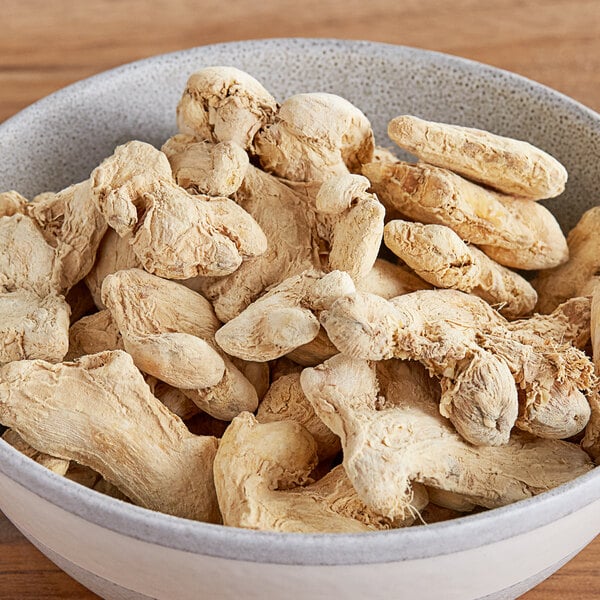
Ginger is a spicy, aromatic rhizome widely used in savory and sweet dishes. It originated in Southeast Asia and has become a staple in global cuisine, appreciated for its warmth, zest, and health benefits. Its natural oils and compounds make it popular in teas, stir-fries, marinades, and baked goods.
- Class: Rhizome
- What does ginger look like? Irregular, knobby root with thin, tan skin and firm, fibrous yellow flesh.
- What does ginger taste like? Spicy and peppery with a hint of lemon and a slight sweetness.
- How to clean ginger: Rinse ginger root under water to remove dirt, then peel the skin with a spoon or vegetable peeler.
- How to use ginger: Grate or mince ginger to add to sauces, marinades, curries, or tea. Use ginger either fresh, powdered, or candied in various dishes.
- How to store ginger: Store unpeeled ginger in a cool, dry place for up to 2 weeks, or refrigerate in a plastic bag for a longer shelf life. Freeze ginger for long-term use.
Types of Ginger
The various types of ginger offer unique flavors and advantages.
- Young (Baby) Ginger: Pale, tender, milder in flavor with thin skin, ideal for pickling or fresh use in dishes.
- Mature Ginger: Stronger, spicier flavor with thicker skin, ideal for drying, grinding, or cooking in robust dishes.
- Blue-Ring Ginger (Hawaiian Ginger): Features a distinctive blue-green ring inside its flesh, known for its milder flavor and juicier texture.
- Ground Ginger: Dried and powdered form of ginger root, used as a spice.
7. Cassava (Yuca)
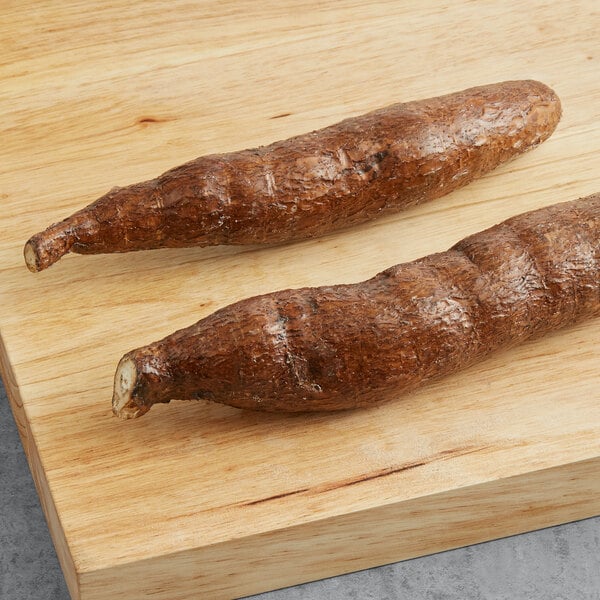
Cassava, or yuca, is a starchy tuber from South America. Its neutral flavor and versatility make it a staple in tropical cuisines. Often boiled, fried, or ground into flour, cassava is common in gluten-free baking, stews, and traditional Latin American dishes like empanadas and fritters.
- Class: Tuberous root
- What does cassava look like? Long and cylindrical with thick, brown skin and white, dense flesh.
- What does cassava taste like? Mild, starchy, and slightly nutty, similar to potatoes.
- How to clean cassava: Scrub the cassava under water, then peel away the tough, inedible skin before cooking.
- How to use cassava: Boil, fry, or steam cassava for various dishes. It can also be ground into cassava flour for gluten-free baking.
- How to store cassava: Store fresh cassava in a cool, dark place for a few days or refrigerate peeled cassava in water for up to 2 weeks. Freeze cooked cassava for long storage.
Yuca vs Yucca
Though they sound similar, yuca and yucca are nothing alike. Yuca is an edible root vegetable from South America, while yucca is a flowering plant from desert regions like Arizona. Most of the yucca plant is not edible, but it is used in soap and shampoo.
8. Carrots

Carrots are vibrant, crunchy root vegetables that are a favorite in many kitchens due to their sweet flavor and versatility. These nutrient-packed vegetables are rich in beta-carotene, an essential nutrient for eye health. Carrots complement sweet and savory dishes and can be enjoyed raw, cooked, or juiced.
- Class: Taproot
- What do carrots look like? Long and tapered with smooth skin. They come in various colors, from orange to purple, yellow, and red.
- What do carrots taste like? Sweet and earthy, with raw carrots offering a crisp texture and cooked carrots becoming tender and sweeter.
- How to clean carrots: Scrub carrots under water to remove dirt. Peeling is optional, depending on the preparation.
- How to use carrots: Carrots can be eaten raw, shredded in salads, roasted, boiled, or mashed. Use them in soups, stews, stir-fries, and even desserts like carrot cake.
- How to store carrots: Store unpeeled carrots in the refrigerator in a plastic bag for up to 2 weeks.
Types of Carrots
The following types of carrots are used in professional kitchens throughout the industry.
- Nantes Carrots: Cylindrical, smooth-skinned carrots with sweet, tender flesh.
- Chantenay Carrots: Short and stout with a conical shape, known for their crisp texture and ability to grow well in heavier soils.
- Imperator Carrots: Long, slender, and slightly tapered, commonly used in commercial production for their vibrant color and mild, sweet flavor.
- Danvers Carrots: Thick and tapered, ideal for growing in shallow or rocky soils, with a deep orange color and robust flavor.
- Purple Carrots: Deep violet exterior and slightly spicy with orange or yellow flesh.
Back to Top
9. Yams
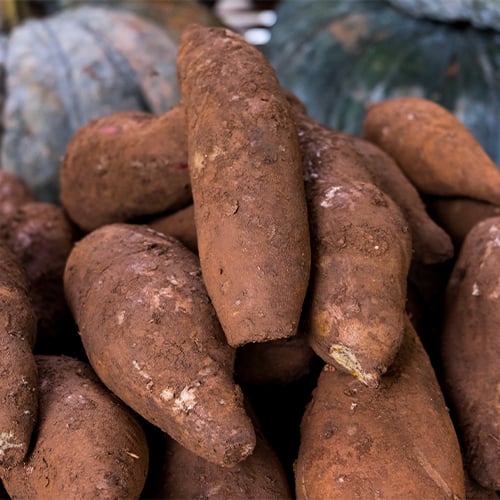
Yams are a starchy, dry-fleshed tuber primarily grown in Africa and the Caribbean. They are often confused with sweet potatoes but differ significantly in texture and flavor. Typically used in savory dishes, yams require thorough cooking to soften their dense flesh.
- Class: Tuber
- What do yams look like? Large, cylindrical tuber with rough, bark-like skin and white, purple, or reddish flesh.
- What do yams taste like? Mild and starchy, with a dry, firm texture. Less sweet than sweet potatoes.
- How to clean yams: Scrub the yam under cold water, then peel away the tough, rough skin with a knife or vegetable peeler before cooking.
- How to use yams: Yams can be boiled, mashed, roasted, or fried. They are found in West African and Caribbean stew, soup, or porridge.
- How to store yams: Store yams in a cool, dry place for several weeks. Do not refrigerate, as it can alter their texture.
Yams vs Sweet Potatoes
Yams and sweet potatoes are often confused due to their similar appearance but differ in texture, flavor, and origin. Yams have rough, bark-like skin with dry, starchy flesh, while sweet potatoes have smooth skin and moist, sweet flesh. Yams are native to Africa and Asia, while sweet potatoes are native to Central and South America. Additionally, yams are larger and require longer cooking times than the softer, quicker-cooking sweet potato.
10. Sweet Potatoes

Sweet potatoes are nutrient-dense root vegetables with a naturally sweet flavor. They are a staple in many cuisines and are valued for their versatility and health benefits. Rich in vitamins A and C, sweet potatoes are used in savory and sweet dishes, and their bright orange flesh adds visual appeal to many meals.
- Class: Tuberous root
- What do sweet potatoes look like? Elongated and tapered with smooth skin that can be tan, brown, or purple. The flesh ranges from orange to white or purple.
- What do sweet potatoes taste like? Sweet, creamy, and earthy
- How to clean sweet potatoes: Scrub sweet potatoes under cold water to remove dirt. Peeling is optional, depending on the recipe.
- How to use sweet potatoes: Sweet potatoes can be roasted, mashed, baked, or fried. They are common in casseroles, pies, and soups, as well as in purees and fries.
- How to store sweet potatoes: Store sweet potatoes in a cool, dark place for up to 4 weeks. Do not refrigerate, as it can alter the texture.
Sweet Potatoes vs Potatoes
Sweet potatoes and regular potatoes share similar uses in the kitchen but differ in flavor, texture, and nutritional content. Sweet potatoes are sweeter and have a softer, more moist texture when cooked, while potatoes vary in starchiness and tend to have a more neutral flavor. Nutritionally, sweet potatoes are higher in fiber, vitamins, and antioxidants than regular potatoes.
11. Turnips

Turnips are mildly peppery root vegetables commonly used in soups, stews, and roasts. They are versatile and can be eaten raw or cooked, offering a slightly bitter flavor when raw and a sweet, mellow taste when roasted or boiled. Turnip greens are also edible and nutrient-rich.
- Class: Taproot
- What do turnips look like? Round and bulbous, with purple or white skin and creamy-white flesh.
- What do turnips taste like? Slightly bitter and earthy when raw, becoming sweeter and milder when cooked.
- How to clean turnips: Scrub thoroughly under cold water to remove dirt. Peeling is optional, and younger turnips are frequently cooked with their skin on.
- How to use turnips: Turnips are roasted, boiled, mashed, or added to soups and stews. They can also be grated raw into salads for added crunch.
- How to store turnips: Store turnips in the refrigerator, unwashed, for up to 2 weeks in a plastic bag.
Types of Turnips
The types of turnips are distinguished by their different colors.
- Purple Top Turnip: The most common variety, with a purple and white exterior and mildly sweet flesh.
- Tokyo Turnip: Small, white, and tender with a delicate, sweet flavor.
- Golden Ball Turnip: Golden-yellow skin with sweet, creamy flesh, excellent for roasting.
12. Celeriac

Celeriac, or celery root, is a knobby, bulbous vegetable offering mild celery flavor and a starchy texture. It is often used in soups, purees, and gratins, adding an earthy note to many dishes. Celeriac is renowned for its low-calorie content and high vitamin K levels.
- Class: Taproot
- What does celeriac look like? Rough, knobby, brown exterior with pale, creamy flesh.
- What does celeriac taste like? Mild, with a celery-like flavor and slightly nutty undertones.
- How to clean celeriac: Use a brush to scrub away dirt, then peel away the rough outer skin with a sharp knife or peeler.
- How to use celeriac: Celeriac can be mashed, roasted, or added to soups and stews. It can also be grated and used raw in salads or slaws.
- How to store celeriac: Store celeriac in the refrigerator for up to 2 weeks. It is also peeled, cubed, and frozen for long storage.
Celeriac vs Celery
Although celeriac and celery come from the same plant family, they are distinct in appearance and use. Celery is grown for its crisp stalks, which are raw or cooked in various dishes. Celeriac is the root of the plant and is prized for its starchy texture and subtle celery flavor, making it ideal for soups, mashes, and gratins. They are not interchangeable.
13. Turmeric
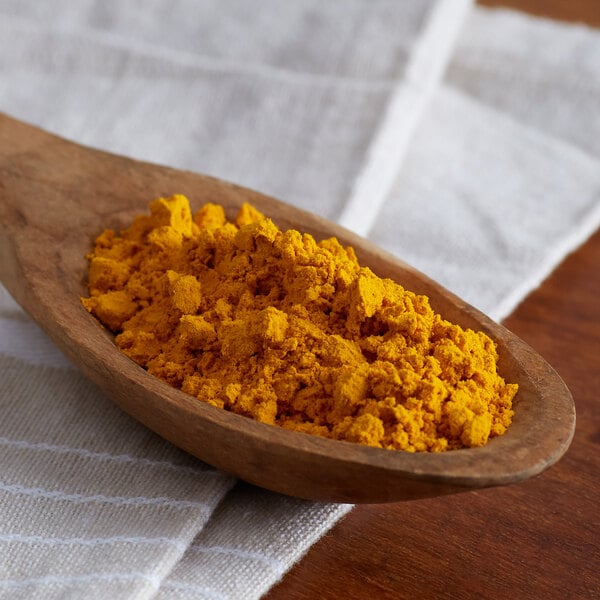
Turmeric is a bright, orange-yellow rhizome known for its warm, earthy flavor and powerful anti-inflammatory properties. It is often used in curries, sauces, and teas, both for its distinct taste and its vibrant color. Turmeric is a crucial ingredient in many Indian, Southeast Asian, and Middle Eastern cuisines.
- Class: Rhizome
- What does turmeric look like? Small, knobby root with bright orange or yellow flesh, covered by thin, tan skin.
- What does turmeric taste like? Earthy, bitter, and slightly peppery with hints of ginger.
- How to clean turmeric: Scrub under cold water and peel the skin with a spoon or vegetable peeler before use.
- How to use turmeric: Turmeric can be grated or chopped fresh into curries, soups, and sauces. It is also commonly used in powdered form in exotic spice blends or added to beverages like golden milk and teas.
- How to store turmeric: Store fresh turmeric in the refrigerator for up to 2 weeks, or freeze it for long-term storage. Store dried turmeric in an airtight container in a cool, dark place.
Turmeric vs Ginger
Both turmeric and ginger are rhizomes with similar appearances but differ significantly in flavor and culinary use. While ginger is spicy and pungent, turmeric is more earthy and bitter. Ginger is often used in sweet and savory dishes, while turmeric is only used in savory applications for its distinct flavor and color.
14. Parsnips
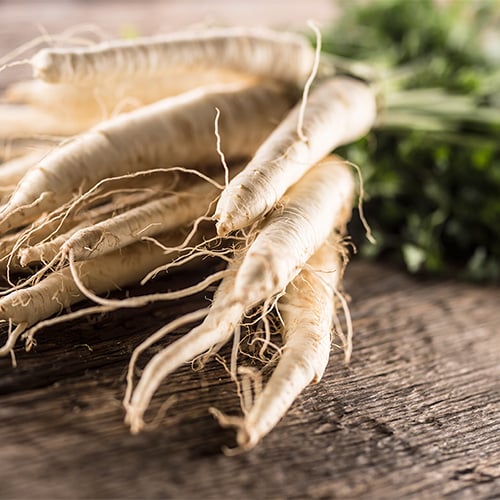
Parsnips are pale, carrot-like root vegetables with a sweet, nutty flavor that intensifies when cooked. They are a popular winter vegetable, often roasted, mashed, or added to soups and stews. Parsnips are also a good source of fiber, vitamin C, and folate, making them both nutritious and delicious.
- Class: Taproot
- What do parsnips look like? Long and tapered, resembling a pale white carrot with creamy flesh.
- What do parsnips taste like? Sweet, nutty, and slightly spicy, particularly when roasted.
- How to clean parsnips: Scrub parsnips under cold water to remove dirt. Peeling is optional, though older parsnips may have tough skin that should be peeled.
- How to use parsnips: Parsnips can be roasted, mashed, or pureed. They are also a flavorful addition to soups, stews, and casseroles.
- How to store parsnips: Store parsnips in the refrigerator in a plastic bag for up to 3 weeks.
Parsnips vs Turnips
Parsnips and turnips differ in both flavor and texture. While parsnips are sweet and slightly nutty, turnips have a more bitter, earthy taste. Parsnips also have a denser, starchier texture compared to the firmer, slightly watery consistency of turnips.
Parsnips vs Carrots
Parsnips and carrots share a similar appearance but differ in flavor. Parsnips have a sweeter, nuttier taste than carrots' crisp, sweet, and earthy flavor. Carrots are eaten raw or cooked, while parsnips are usually cooked to bring out their sweetness.
Parsnips vs Radishes
Though they look alike, parsnips and radishes have different flavors, textures, and culinary applications. Parsnips have a sweet, earthy taste, especially after exposure to frost, and their texture is dense and starchy, making them ideal for roasting, mashing, and soups. Radishes have a crisp, peppery bite that adds a refreshing contrast to dishes, typically eaten raw in salads or as garnishes. While parsnips are key ingredients to warm, hearty recipes, radishes work best as a crunchy, bright accent, lending a fresh sharpness that complements various foods.
15. Radishes

Radishes are crisp, peppery root vegetables that add crunch and a spicy bite to salads, slaws, and garnishes. Available in various shapes, sizes, and colors, radishes are versatile ingredients that are raw or lightly cooked. Their peppery flavor mellows when roasted or pickled.
- Class: Taproot
- What do radishes look like? Small and round or elongated, with smooth skin that ranges from red to white, pink, purple, or black.
- What do radishes taste like? Sharp, peppery, and slightly sweet, with a crisp, juicy texture.
- How to clean radishes: Rinse radishes under cold water to remove dirt. Trim the ends before use.
- How to use radishes: Radishes can be eaten raw in salads, slaws, and sandwiches or roasted, pickled, or sauteed for a milder flavor.
- How to store radishes: Store radishes in the refrigerator for up to 2 weeks. For lengthy storage, keep them in a container of water in the fridge.
Types of Radishes
The following types of radishes are common in the foodservice industry.
- Red Globe Radish: Small, round, and red-skinned with a crisp texture and spicy bite.
- Daikon Radish: Long, white, and milder in flavor, often used in Asian cuisine.
- Watermelon Radish: Green or white exterior with vibrant pink flesh, offering a milder, sweet flavor.
- Black Radish: Dark-skinned with a strong, peppery flavor, used in salads or pickled.
Back to Top
Root vegetables offer diverse flavors, textures, and nutrients that enhance any professional kitchen's culinary repertoire. Whether you're working with the earthy richness of beets, the crisp bite of radishes, or the sweet, starchy satisfaction of sweet potatoes, each root vegetable brings its unique qualities to a meal. By understanding their classifications, preparation methods, and best uses, chefs can better incorporate these versatile ingredients into various dishes.



